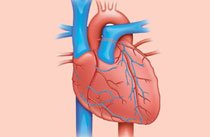BeTheChange
Moderator
- Messages
- 2,250
- Reaction score
- 219
- Gender
- Female
- Religion
- Islam

Don't run away (click away) it's time for a biology lesson! Alhamdulilah.
Your heart and circulation

Every part of your body needs a fresh supply of blood in order to work normally. It's your heart's job to make sure that this is pumped out regularly.
Understanding the cardiovascular system
The movement of blood around the body, pumped by the heart, is called circulation. Your heart, blood and blood vessels together make up your cardiovascular system (or heart and circulatory system).
Your body contains about five litres (eight pints) of blood, which your heart is continuously circulating.
How blood travels around your heart

The two sides of your heart are separate, but they work together.
- The right side of the heart receives dark, de-oxygenated blood which has circulated around your body.
- It pumps this to your lungs, where it picks up a fresh supply of oxygen and becomes bright red again.
- The blood then returns to the left side of the heart, ready to be pumped back out to the rest of your body.
There are four valves in your heart. They act like gates that open and close, making sure that your blood travels in one direction through your heart – a bit like a one-way traffic system. They are called the tricuspid valve and the pulmonary valve on the right side of the heart, and the mitral valve and the aortic valve on the left.
Like every other living tissue, the heart itself needs a continuous supply of fresh blood. This comes from the coronary arteries which branch off from the main artery (the aorta) as it leaves the heart. The coronary arteries spread across the outside of the myocardium, supplying it with blood.
How blood travels around your body
As your heart muscle contracts, it pushes blood through your heart. With each contraction, or heartbeat:
- Your heart pumps blood from its left side, through the aorta (the main artery leaving the heart) and into the arteries.
- The blood travels through your arteries, which divide off into smaller and smaller branches of blood vessels called capillaries. Travelling through this network of capillaries, blood reaches every part of your body.
- The de-oxygenated blood then travels back to the heart through your veins. Branches of veins join to form larger veins, which lead back to the right side of your heart.
- From here, your heart will pump the de-oxygenated blood to your lungs with its next heartbeat.
As the heart relaxes in between each heartbeat or contraction, blood from your veins fills the right side of your heart. At the same time, blood that’s freshly full of oxygen from your lungs fills the left side ready for the entire process to start again.
What can go wrong?
Problems with your heart and circulation system, including heart attack, angina and stroke, are forms of cardiovascular disease.
This can occur when your arteries become narrowed by a gradual build-up of fatty material (called atheroma) within their walls. In time, your arteries may become so narrow that they cannot deliver enough oxygen-rich blood to your heart. This can cause angina – a pain or discomfort in your chest.
If the fatty material breaks off (or ruptures), a blood clot will form, which can cause stroke and heart attack.
Find out more about cardiovascular disease and how you can reduce your risk of developing it.
Source: https://www.bhf.org.uk/heart-health/how-your-heart-works/your-heart-and-circulation


 .. also emphasised the importance of physical exercise .
.. also emphasised the importance of physical exercise . and the sahabah
and the sahabah did regularly
did regularly